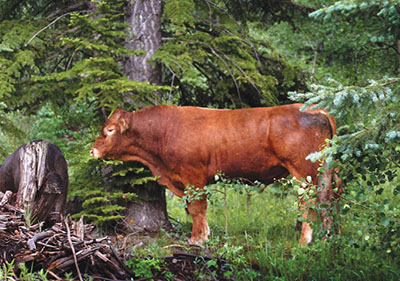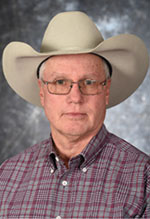Trichomoniasis in Beef Cattle
Guide B-230
John C. Wenzel
College of Agricultural, Consumer and Environmental Sciences, New Mexico State University
Author: Extension Veterinarian, Department of Extension Animal Sciences and Natural Resources, New Mexico State University. (Print Friendly PDF)
Introduction
Trichomoniasis—or “trich” for short—is a sexually transmitted disease of cattle caused by the protozoa Tritrichomonas foetus. The disease is characterized by an increase in open cows detected at pregnancy check and/or an increase in dry cows at spring branding. Trich can cause an increase of both calving interval and overall length of the calving season. All of these effects can result in a severe and rapid economic loss for ranches. To protect the cattle industry and to control the disease in New Mexico, trich became a reportable disease in July 2005. The disease now has rules and testing requirements in place for breeding cattle. Contact the New Mexico Livestock Board (www.nmlbonline.com) for a copy of these rules.

Photo courtesy of Clay Mathis.
Trichomoniasis in Cows
The disease caused by T. foetus is strictly a venereal disease of cattle that does not make cows or bulls sick. Cows develop trich after being bred by an infected bull. The infection develops in the cow’s reproductive tract and may result in a loss of pregnancy. After the pregnancy loss, the cow will come into heat 3 to 5 times until her immune system mounts enough of a response to clear the disease and then rebreed. She will expose any bull that breeds her until the organism is cleared. Cows will clear the infection about 97% of the time if given the opportunity for sexual rest of about five months. The remaining 3% of cows may become carrier cows that remain infected but have a calf. These carrier cows will remain infected well into the next breeding season.
Immunity from the disease will only last for about 12 to 15 months; thus, a cow can become reinfected if bred by an infected bull the next year. A few infected cows develop scarring in the uterus that makes them infertile. There is no medication available that is effective in treating this disease.
Trichomoniasis in Bulls
The bull is a mechanical spreader of T. foetus. The trich organism lives on the surface of the penis and prepuce in small folds called crypts. The older the bull, the deeper and more numerous the crypts are, so it is easier for bulls 4 years of age or older to become chronically infected. However, younger bulls (as young as yearlings) can develop the infection, and some may become chronically infected. The bull contracts trich by breeding an infected cow and picking up T. foetus on the surface of the penis. Due to the nature of disease contraction and site of infection, there is limited response by the bull’s immune system, so he develops very little resistance to the organism. There is no treatment for this disease, and infected bulls can only be sold for slaughter.
Diagnosis
The disease is very difficult to diagnose in the cow. It requires five successive negative tests, with at least one week between each test, to classify a cow as negative for the disease. The test is performed on cervical mucus samples. For this reason, most testing is done on the bull.
In New Mexico, the official test is called a PCR test (polymerase chain reaction test). PCR is based on the DNA of the organism and is both very specific and sensitive. This test is performed on samples collected by scraping the penis and prepuce of breeding bull. The samples can only be collected by veterinarians certified to test by the New Mexico Livestock Board. A list of certified veterinarians is available from the Livestock Board or on their website at www.nmlbonline.com.
Control
Control measures help to limit exposure and spread of trich and are only one component in a complete program to prevent or eradicate the disease. Contact your local veterinarian for information regarding prevention and eradication.
- Test all bulls at the end of the breeding season and cull any positives.
- Test all incoming bulls that are added to the bull battery.
- Do not share or lease bulls unless a trich prevention program is in place.
- Do not add cattle from unknown herds or with unknown calving histories.
- Keep fences in good repair to prevent exposure to neighboring cattle.
- Communicate with neighbors regarding trich status.
Prevention
To prevent the disease from entering a clean herd, only add bulls with a negative test and cows or heifers from known negative herds. Annual testing of the bull battery is recommended to catch the disease early if exposure does occur. Prioritizing testing of mature bulls over that of yearling bulls is most effective in monitoring trich status, but all sexually active bulls pose a risk. A commercial vaccine is available for females and has shown to increase the number of live births in exposed herds. This vaccine can be used in a prevention program, but label directions must be strictly adhered to since it has a very short duration of efficacy. The vaccine, in limited studies, has shown to be an aid in preventing colonization of the organism in the sheath of bulls.
Economics
Trichomoniasis is a disease that can be economically devastating in a short period of time. A susceptible cow that is bred by an infected bull will become infected with the organism and will generally abort, recycle 3-5 times, and then settle, infecting all bulls that breed her while she is infected. A cow that rebreeds will calve 4 to 6 months later than normal, with an accompanying loss of weaning weight. Many cows will not rebreed and will have to be sold as open cows. Other cows that were pregnant at pregnancy check may abort, and abortion can occur as late as 240 days of gestation. In the first year, the loss in calf crop can be 10 to 30%—and as high as 50%—depending on the number of positive bulls that are turned out with susceptible cows. A herd that has one positive test is quarantined and must meet requirements set forth by the NM Livestock Board for the quarantine to be lifted. The rules associated with this disease will affect both the quarantined operation and all of their neighbors, so it is of the utmost importance that ranches do all they can to prevent this disease from being introduced to their cowherd. Quarantine does not affect the sale of weaned calves. Preventing trich from being introduced into your herd is the key to avoiding this economic loss.
For More Information
For information about state regulations, testing requirements, or import requirements for breeding stock, contact the New Mexico Livestock Board at 505-841-6161 or on the web at www.nmlbonline.com.
For more information about trich prevention and control programs, contact your local veterinarian.
For more general information about trichomoniasis, contact the author at jwenzel@nmsu.edu or 575-534-7562, or the Department of Extension Animal Sciences and Natural Resources (https://aces.nmsu.edu/ces/animal/). For other Extension livestock and range publications, visit https://pubs.nmsu.edu/_b/.
For Further Reading:
B-121: Biosecurity on the Beef and Dairy Operation
https://pubs.nmsu.edu/_b/B121/
B-222: Cattle Vaccination and Immunity
https://pubs.nmsu.edu/_b/B222/
B-224: Cow Herd Vaccination Guidelines
https://pubs.nmsu.edu/_b/B224/

John C. Wenzel is the Extension veterinarian in the Extension Animal Sciences and Natural Resources department at NMSU. He earned his B.S. from NMSU and his DVM from Kansas State University College of Veterinary Medicine. His work focuses on cow/calf medicine and preventative health programs for livestock producers in southwestern New Mexico.
To find more resources for your business, home, or family, visit the College of Agricultural, Consumer and Environmental Sciences on the World Wide Web at pubs.nmsu.edu.
Contents of publications may be freely reproduced, with an appropriate citation, for educational purposes. All other rights reserved. For permission to use publications for other purposes, contact pubs@nmsu.edu or the authors listed on the publication.
New Mexico State University is an equal opportunity/affirmative action employer and educator. NMSU and the U.S. Department of Agriculture cooperating.
Revised September 2019 Las Cruces, NM


